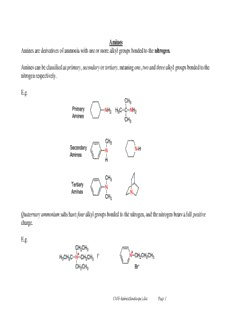
Amines - Rutgers University PDF
Preview Amines - Rutgers University
Amines Amines are derivatives of ammonia with one or more alkyl groups bonded to the nitrogen. Amines can be classified as primary, secondary or tertiary, meaning one, two and three alkyl groups bonded to the nitrogen respectively. E.g. Quaternary ammonium salts have four alkyl groups bonded to the nitrogen, and the nitrogen bears a full positive charge. E.g. Ch19 Amines(landscape).docx Page 1 Amines are a very common functional group in organic chemistry, and especially so for naturally occurring compounds. E.g. Ch19 Amines(landscape).docx Page 2 Nomenclature The IUPAC nomenclature is analogous to that for alcohols, except the -e ending is replaced with -amine. Other substituents on the carbon chain are given numbers, and the prefix N- is used for each substituent on Nitrogen. E.g. Ch19 Amines(landscape).docx Page 3 Aromatic amines are often called by their historical/trivial names, with phenylamine being called aniline. Other Nitrogen heterocycles have ring system names that need to be learnt also. (The N is normally considered to be numbered 1). Ch19 Amines(landscape).docx Page 4 Structures of Amines Previously we have seen that ammonia (NH ) has a slightly distorted tetrahedral shape, due to the compression of 3 the ideal 109.5° angle by lone pair-bond pair repulsion. This effect is less pronounced with alkyl groups, and trimethylamine has bond angles closer to the perfect sp3 arrangement than ammonia. Since an amine has three substituents and a lone pair, the question of chirality arises. If an amine has three different substituents (and its lone pair) can we resolve the amine into enantiomers? Ch19 Amines(landscape).docx Page 5 In most cases, this is not possible since the enantiomers can interconvert through a low energy pathway. The interconversion takes place through a nitrogen inversion, where the lone pair moves from one face of the molecule to the other, and back. The lone pair starts off in an sp3 orbital, but in the transition state of the inversion, the nitrogen can rehybridize to sp2, with the lone pair in a p orbital. This is not a high energy situation, and only requires 6kcal of energy to achieve this TS (therefore easy at room temperature). At the TS, the inversion can occur or return back to the original enantiomer - single enantiomers cannot be resolved in most cases. Exceptions There are certain special cases where amines are chiral. (In the C-I-P convention, lone pairs have the lowest priority). Ch19 Amines(landscape).docx Page 6 Case 1: Amines whose chirality stems from the presence of chiral carbon atoms. E.g. butan-2-amine. Case 2: Quaternary ammonium salts with chiral nitrogen atoms. Here the nitrogen inversion is impossible since there are four substituents on the N, and no lone pair. E.g. Ch19 Amines(landscape).docx Page 7 Case 3: Certain amines cannot attain the sp2 hybridization required for nitrogen inversion. Examples of this include nitrogen atoms in small rings (aziridines). The required bond angle of 120° is unobtainable in the strained system, and so the TS required for nitrogen inversion is of too high energy, and thus chiral aziridines can be resolved into enantiomers. Ch19 Amines(landscape).docx Page 8 Basicity of Amines The nitrogen atom of amines has a lone pair of electrons, and this gives rise to characteristics of nucleophilicity and basicity. Amine as a nucleophile: Amine as a base: Amines are basic, and therefore their aqueous solutions are basic (pH>7), and recall that base strength is talked of in terms of base-dissociation constant (K ). b Ch19 Amines(landscape).docx Page 9 The values of K for most amines are small (10-3), but still basic. b Since amine basicity values span many orders of magnitude, discussion of pK values is more common. b Remember pK = -log K b 10 b And that K K =K = 10-14 a b w Ch19 Amines(landscape).docx Page 10
Description: